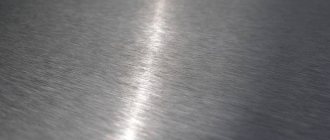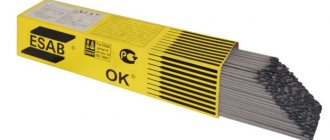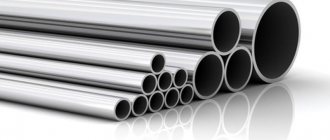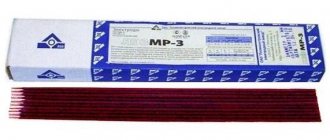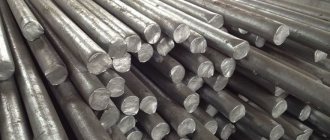Chemical composition of structural steel 35L
The consumer properties of 35L steel are determined by the percentage of carbon and other chemical elements, which are distributed as a percentage as follows:
- iron (Fe) – approximately 97%;
- carbon (C) – 0.32–0.4%;
- manganese (Mn) - 0.45–0.9%;
- silicon (Si) – 0.2–0.52%;
- sulfur (S) – 0.06%;
- phosphorus (P) – 0.06%.
Manganese and silicon are added for good machinability. The proportion of P and S impurities depends on the casting group.
Steel 35 structural carbon quality
A variety of materials can be used to create various parts and mechanisms. Among the metals, steel 35 should be noted. It belongs to the class of high-quality carbon structural steels and is considered the most affordable offer. Steel 35 (GOST 1050-88 previously determined the basic qualities and chemical composition, now it has been replaced by GOST 1050-2013) is used to produce industrial fasteners of various types.
Characteristics of steel 35L
Castings from 35L are produced using the most popular and modern technology for producing cast products - the method of casting using gasified models. This method makes it possible to produce castings from 35L steel with high dimensional accuracy, complete identity of parts in a series, of varying complexity and low cost.
MECHANICAL PROPERTIES:
- yield strength 343 MPa;
- tensile strength 540 MPa;
- relative elongation 16%;
- relative narrowing 20%.
The hardness for metal products 35L (HB 10 -1) is 137–229 MPa.
CASTING PROPERTIES AND DENSITY
| Linear shrinkage | 2,2-2,3% |
| Tendency to form shrinkage cavities | 1.2 ku.r. |
| Tendency to form shrinkage porosity | 1.0 cu.p. |
| Fluidity | 1.0 Kzh.t. |
| Crack resistance index | 0.8 Kt.u. |
35L steel has limited weldability. To avoid the formation of defects during welding, heating to 100–120°C is required, followed by heat treatment. Steel density is 7830 kg/m3.
Physical properties
The main characteristics and application of steel 35 depend on the chemical composition.
The density of the metal decreases with increasing temperature. In the range from 20 to 800 degrees it changes from 7826 to 7600 kg/m3. At the same time, the ductility of steel increases. The density indicator is necessary when calculating the load on load-bearing structural elements.
With increasing temperature, other physical properties of the material also change:
- electrical resistivity – from 251 to 1156*109 Ohm*m at 900 degrees;
- specific heat capacity – 469-699 J/kg*deg;
- linear expansion coefficient – from 12 to 13.9 1/deg;
- the thermal conductivity coefficient decreases from 49 to 28 W/m*deg;
- The modulus of elasticity also decreases in the range of 20-400 degrees from 2.06*10-5 to 1.68*10-5 MPa.
Mechanical parameters
The hardness of the alloy is 163 MPa. The indicator can be increased using heat treatment. Most often, the normalization mode is used for this purpose, which normalizes the metal structure and increases surface hardness.
Application of 35L steel castings
35L steel produced in accordance with GOST 977 88 is relevant in machine tool and mechanical engineering, the construction industry, and in the manufacture of tools. Medium-carbon steel is used for the manufacture of products and parts that function optimally under conditions of average operating (static and dynamic) loads in the temperature range from -40°C to +450°C. AZTL LLC provides single, serial and mass production of the following parts from 35L steel: machine beds, gear wheels, brackets, rods, parts for pipeline fittings, hydraulic turbines, etc.
| Details | Products |
| Heat exchangers | Housings |
| Turbomachines | Beds |
| Rolling mills | Rows, runners |
| Hydro turbines | Tension rings |
| Steam boilers | Floating heads |
| Gears | Flanges, valves, rolls |
| Frames of gyroscopes, stabilizers | Brackets |
| Housing bracket AT 063.00.00.526 | Carbonizer 01.612.115.007.2 | Cover NKR100M-1-1071 for drilling rig NKR100M | Bottom block 7.07.011 for drilling rig SKB-5115 |
| Horseshoe No. 2 | Anchor Admiralty invalid | Cover NKR100M-1-1071 for drilling rig NKR100M | Double flanged slope PTM 316.1-161 |
Application of steel 35
As previously noted, the metal in question is widely used. This is due to the low production cost and fairly high performance characteristics. The alloy is often used to produce the following parts:
- Characterized by low strength and experiencing low stress. This group includes crankshafts, axles, cylinders, rims, traverses and others.
- Various fasteners: bolts, nuts and studs. They are cheap, but cannot be used in the manufacture of wear-resistant parts.
When choosing this alloy, it should be taken into account that due to the fairly high carbon concentration, the degree of weldability is significantly reduced. Therefore, in most cases, workpieces are supplied for machining. Corrosion resistance is average; the resulting parts can be used in moderately aggressive environments. The resulting bolts are often used when constructing foundations or creating other load-bearing structures.
Download GOST 1050-2013
Analogs of steel 35 have similar chemical composition and properties, and are marked when applying GOST standards. Other countries have their own standards. For example, in the USA, analogues are called 1034, 1035; alloys ML35 and ZG270-500 are supplied from China. A more affordable offer is metals produced by domestic companies.
Order steel casting grade 35l
All steel products manufactured at AZTL meet strict GOST requirements and ensure increased purity of the casting structure. You can order and buy 35L steel castings on the company’s website or by phone. It is possible to quickly produce serial castings according to technical requirements, drawings or samples of the customer’s product (part). Call right now - qualified managers will answer all questions regarding ordering, assortment, technical characteristics of metal products, cost, payment methods and delivery.
Welding steel
Content:
Steel is considered a durable material that is used in various fields.
Important structures are made from it - fencing, elements for building cladding, various equipment, pipes and other products. The strength of the base is ensured by the content of various additives in its composition. The constituent components influence not only the strength of the metal, but also the ability to weld. Welding steel can depend on various indicators - properties, strength, additional components. That is why some types of metal are welded quickly and easily, while others, on the contrary, require a special approach.
Welding of heat-resistant steels
Welding of heat-resistant steels is usually performed using arc welding using a tungsten electrode. The entire process usually takes place in a protective gas environment - argon or helium.
Welding of steel 15x5m and larger sizes can be carried out using argon arc welding using non-consumable or consumable electrodes or using automatic submerged arc welding.
Argon welding of steel 20x, 30x, 40x compared to welding in a helium protective environment is accompanied by lower gas consumption, low arc voltage and high welding current. For this reason, it is the most popular.
Welding heat-resistant steel 40x, 20x, 30x, the technology of which requires joining the metal in a state after hardening, has several features. During the welding process, the metal warms up to 1050-1100 degrees and then cools sharply.
Welding of steel pipelines from any type of metal (low-carbon, medium-carbon, stainless, heat-resistant) can be performed in different ways. The most popular are manual arc, automatic, and gas welding. But in any case, before welding of 30xgsa steel and other grades is carried out, the technology must be fully studied.
Classification of steels by weldability
Welding steel 45, 40, 20 and other grades, depending on the important qualities of the metal base, can have different characteristics.
Depending on the degree of weldability, steel is divided into several groups:
- good weldability, while the carbon equivalent indicator SEq. must be at least 0.25%, more is allowed. It does not depend on weather conditions, the size of the thickness of the products, or the presence of preparatory work;
- satisfactory weldability indicator - the SEq indicator should be more than 0.25%, but not higher than 0.35%. At the same time, there are restrictive standards for environmental conditions and for the diameter dimensions of the welded product. Welding steel 20 should be carried out at air temperatures down to -5 in calm weather, and the diameter size should not exceed 20 mm;
- limited. Indicator Seq. should be from 0.35% to .45%, but the main thing is not more. To obtain a high quality seam, preheating is required. Due to this, it is possible to achieve smooth austenitic transformations, as well as the formation of stable structures;
- poor weldability, at which the indicator Seq. is more than 0.45%. In order to obtain a high-quality and mechanically stable welded joint, preliminary temperature preparation of the edges of the metal base is required. Also, after welding, the structure should be heat treated. To obtain the required microstructure during welding of steel 40, additional heating and cooling must be performed.
Types of stainless steel
Welding dissimilar stainless and regular steels depends not only on the properties of the material, but also on its type. For this reason, in order to choose the appropriate welding method, you should first determine the type of steel.
Based on their main properties, stainless steel is classified into the following types:
Austenitic materials contain a high content of nickel and chromium. Stainless steels are used for the manufacture of welded structures, for the production of tableware, architectural components, chimneys, and cutlery. This type of steel has high ductility, chemical resistance and resistance to mechanical damage.
Martensitic steels contain low levels of carbon and chromium, up to 12%. Metals of this variety are highly brittle, but very hard. They are used to produce cutting devices, household products, turbines, and fasteners that are used in environments with a low level of aggressiveness.
Ferritic steels contain medium levels of chromium. They are not hardened and have increased resistance to aggressive environments. They are mainly used in the mechanical engineering sector for the production of bushings, shafts, and fittings.
Types of stainless steel welding
Welding of martensitic, ferritic and austenitic steels is carried out by almost all known and common welding methods. The most popular methods include:
- manual arc MMA;
- tungsten electrode in an argon atmosphere TIG;
- using semi-automatic welding technologies in an inert atmosphere - MIG/MAG, laser.
Welding of austenitic steels and other types of stainless metal is usually done carefully, taking into account the complex chemical composition and physical properties of the metal. The main qualities that complicate the welding process include:
- when welding stainless steels, the temperature should be lower, in contrast to welding carbon metals;
- welding of dissimilar steels is accompanied by high thermal expansion;
- low level of thermal conductivity.
Features of welding low-carbon steels
Low-carbon metals contain 0.25% carbon. This indicator provides positive features of the foundation:
- good elasticity;
- high plasticity properties;
- significant impact strength;
- The base is ideal for welding.
Low carbon steel is used for welded structures. Also used in the manufacture of products using cold stamping.
How low carbon steel is welded
The technology of welding low-carbon steels is carried out using manual arc welding using coated electrodes. Be sure to remember a few nuances:
- First of all, you need to choose the brand of electrodes. This ensures a uniform structure of the deposited metal;
- welding must be performed quickly and accurately;
- Before starting the work process, you need to prepare in advance the parts that will need to be connected.
The technology of welding carbon steels can be performed by gas welding. Important features include:
- in this case, the process is carried out without the use of additional fluxes;
- for the filler base it is worth using metal wire with a low carbon level;
- when welding is performed correctly, the formation of pores is prevented;
- Important products must be welded with argon.
Once welding is completed, the finished product must be subjected to heat treatment using the normalization method. During this process, the product is heated to 4000C, then cooled and kept in the open air. This procedure makes the structure of the product uniform.
Main features
Welding 30 steel with a low carbon base has several important features that are worth paying attention to:
- high-quality welding of structures made of this material ensures equal strength of the welded joint with the base metal. It also protects against the formation of defects;
- the metal base of the compound has a low carbon content, but the indicators of components such as silicon and manganese are increased;
- During manual arc welding, the heat-affected zone may be subject to overheating. This helps to slightly strengthen the seam;
- the seam, which is made using multilayer welding, has increased fragility;
- Due to the fact that the seams contain a low level of carbon, they have increased resistance to intercrystalline corrosion.
Welding Varieties for Low Carbon Steel
Welding of low-carbon steels can be done using several methods. Moreover, each of them has important features that must be taken into account during welding.
| View | Characteristic |
| Manual arc welding with coated electrodes | In order to accurately select consumables for welding using this method, several important conditions must be taken into account - the finished weld must be without damage, uniform strength of the joint, optimal chemical composition of the metal base of the seam, resistance of the joint to impacts. Welding of steel 45 and other grades is performed with an electrode. In this case, various brands of electrodes can be used. |
| Gas | The process is carried out in a protective argon environment. Additionally, metal base wire is used as a filler base. |
| Electroslag | During this process, fluxes are used. Wire and plate electrodes are selected depending on the main alloy. |
| Automatic and semi-automatic welding | The welding process is carried out in a protective environment. During it, argon or pure helium can be used, but mainly carbon dioxide. |
| Automatic submerged | Welding is performed using electrode wire with a diameter of 3 to 5 mm. Welding 45 steel (20, 30, 40 and other grades) with a semi-automatic machine - 1.2-2 mm. Welding occurs due to electric current with reverse polarity. |
| Welding using flux-cored wires | It is considered the most suitable. The current strength is usually in the range from 200 to 600 A. |
Welding high carbon steel
Welded products are not produced from high-carbon metal. The fact is that this material has a low level of ductility; it is this property that limits the use of metal.
High carbon steel is used for the following purposes:
- during repairs and construction;
- for the manufacture of springs;
- for the production of tools and products that are used for cutting, drilling, woodworking;
- High-strength wire is made from metal;
- structures that have high wear resistance and strength.
How to do it
Welding of high-carbon steels is usually performed using preliminary and concomitant heating of the deposited metal to 150-4000C. Also, after welding, additional heat treatment is carried out to improve strength.
This is necessary because the alloys from the material have high fragility, increased sensitivity to cracks with a hot and cold structure, and also because of the chemical heterogeneity of the welded joint.
Welding technology for high-carbon steels is carried out taking into account the following recommendations:
- After heating, annealing is performed. It is carried out until the structure cools down to 2000C;
- welding 40x, 20x, 30x should not be performed in drafts, or at temperatures below -50C;
- in order to increase the strength properties of the weld, it is necessary to make a smooth transition from one to another metal being welded;
- To obtain a high-quality connection, it is worth using narrow beads when welding. In this case, each layer being deposited must be cooled;
- The rules that apply to compounds made from a medium-carbon base must be followed.


